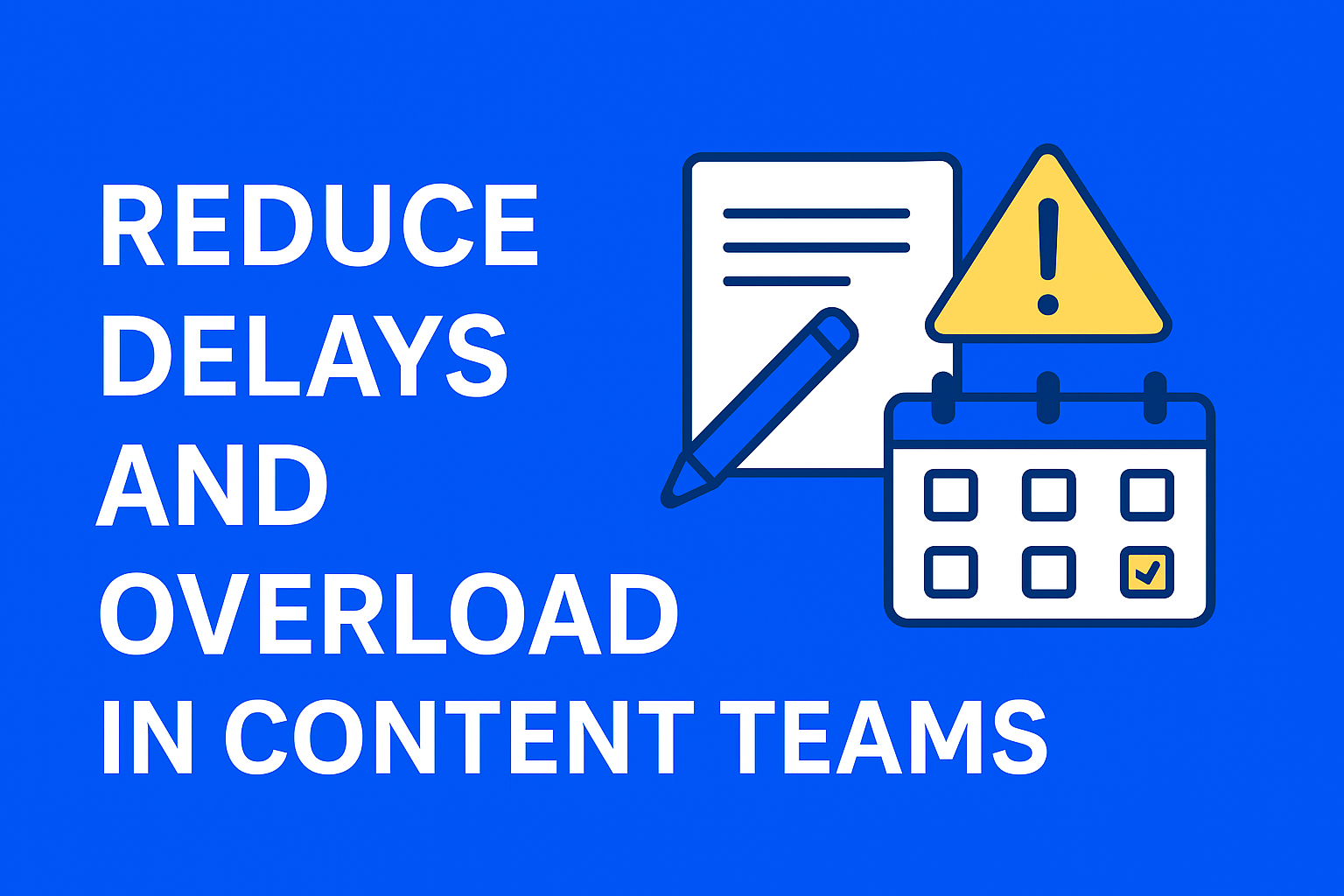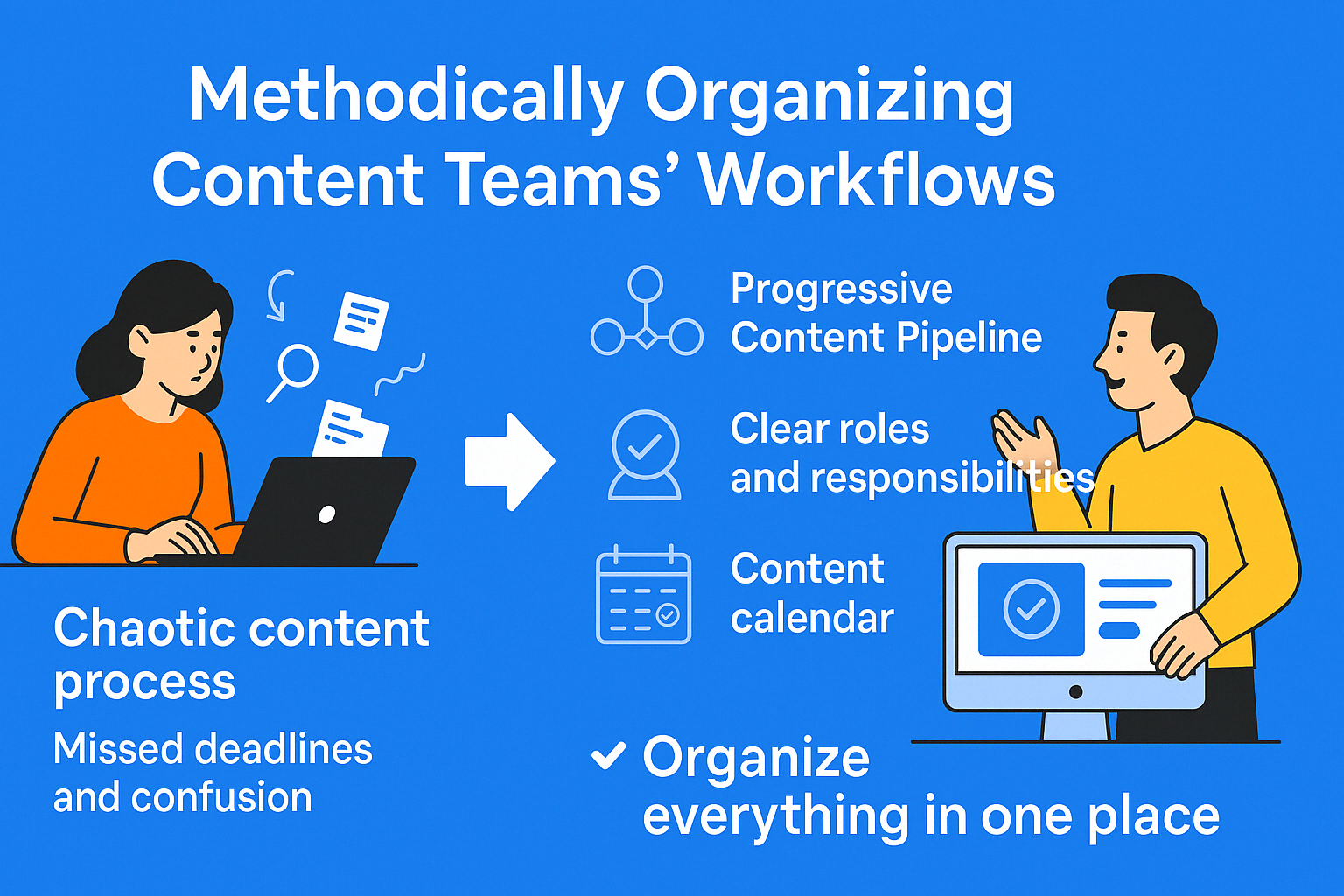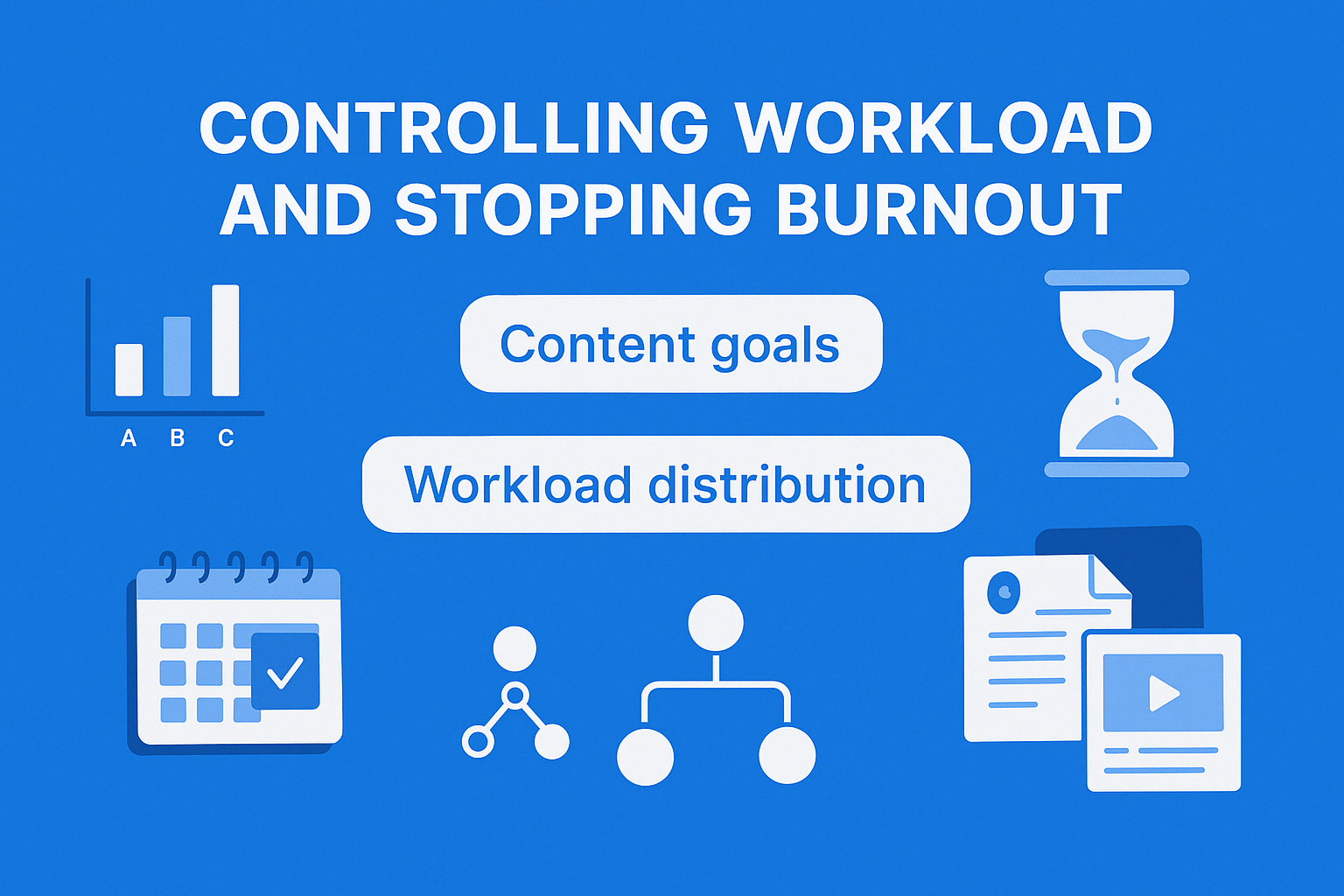How to Reduce Delays and Overload in Content Teams
If your team is constantly missing deadlines, drowning in tasks, and stuck in a loop—you’re not alone. With better structure, clear processes, and tools like EasyContent, you can work smarter, not harder—without the stress or burnout.

Keeping content teams from being too busy and experiencing too many delays
Content teams often get stuck in a never-ending cycle of tight deadlines, too much work, and delays in getting approval. Fresh, high-quality content is becoming more and more important, but teams may quickly feel overworked if they don't have a good process. Every day, writers, editors, and marketers work on a lot of different projects at once. If they don't plan their processes well, they can't avoid delays.
The Secret Cost of Not Being Effective
A broken flow of content not only slows things down, but it also affects quality, team happiness, and even company results.
- Too many tasks kill originality
- Material that is rushed doesn't always hold an audience's attention.
- Things get stuck in limbo because of unclear permission processes.
- Many changes are made because writers, artists, and managers don't talk to each other clearly.
For example, if approvals are slow at a marketing firm, its campaigns and blog posts may regularly miss important publication dates. The team spends more time trying to get approvals and fixing last-minute changes than making good material, which hurts their ability to compete.
How Structure and the Right Tools Could Make a Difference
Content teams that stick to a set process are more likely to be productive and less stressed overall.
- Everyone on the team knows what they need to do.
- There are clear deadlines
- Decisions are made easily.
- Making material more efficiently gets better.
Easy steps that make a difference:
- Calendars for content
- Clear ways to give approval
- Machines that do routine jobs
EasyContent in action: With EasyContent, all of your papers, email threads, and Slack chats are kept in one place. It helps divide up work, keep track of progress, and get approvals without having to go back and forth all the time.
Teams can cut down on unnecessary delays and make sure that material goes easily from being an idea to being published.
How to Make Ecosystems More Productive
Working smarter, not just faster, is needed to cut down on delays and avoid overload.
- The right tools
- A process that is well defined
- Focus on material that adds value.
- What you want with less stress
Whether it's a small group of people writing blog posts or a big company running campaigns across multiple channels, simplicity leads to
✅More work getting done
✅More useful information
✅Long-term results
This article will talk about:
- The main reasons why information is late
- Ways to speed up work that can be done
- How teams can keep working hard without getting tired
Content teams can regularly meet their goals, make more, and worry less if they have the right plan.
🧩 Key Takeaways
- Unstructured workflows lead to overload, delays, and burnout.
- Clear roles, timelines, and approval processes improve team efficiency.
- Automation of repetitive tasks saves time and reduces errors.
- Centralized tools like EasyContent simplify collaboration and planning.
- Proactive scheduling and repurposing content reduce last-minute stress.
- Performance tracking and team feedback help optimize workflows.
- Balancing workload prevents burnout and boosts long-term productivity.
Figuring Out the Main Reasons Why the Content Team Is Late
When content teams are late, they miss targets, produce less, and make people angry. These slowdowns lose time and can lead to content that is rushed, of poor quality, and misses the point.
To fix this, it's important to find the reasons and make changes that make the work run more smoothly.
Problems That Often Happen When Making Content
1. Procedures That Aren't Clear or Aren't Enough
One main reason for material delays is a lack of organized work flow.
When people don't know what their jobs are:
- Things get missed
- There are missed deadlines
- Collaboration is broken up
What can help:
- Defined stages of information
- Duties were given
- Tracking tasks clearly with tools like EasyContent
2. Approval Processes That Don't Work Well
Too many steps for approval or feedback loops that aren't clear slow things down.
Common problems:
- Feedback spread out in chats and emails
- Not a clear due date or approver
- Revision loops that never end
What to do:
- Set up organized review processes
- Limit how many people can accept
- To keep track of comments and approvals, use centralized tools such as EasyContent
3. Teams That Are Too Busy
When too little work is given to too few people, the team runs the risk of:
- Tiredness
- Not meeting due dates
- Not as good of work
A better way to do things is to:
- Checking the team's abilities
- Keeping up with tasks
- A content planner can help you plan ahead
Comparison Table: Chaos vs. Organized Teamwork
| Signs | Not Organized | The Team Organized Itself (with EasyContent) |
|---|---|---|
| Visibility of tasks | Low | High |
| Deadline management | Not always right | Clear and on time |
| Assignment clarity | Roles are not clear | Clear definitions of roles |
| Risk of burnout | Very high | Well run and well-balanced |
| Efficiency of workflow | Broken up | Streamlined and easy to keep track of |
4. Bad Teamwork and Communication
Team members who don't talk to each other enough cause:
- Work done twice
- Lost a message
- Delays in delivering the goods
To avoid this:
- Put conversation and file sharing in one place
- Put all of your changes and improvements in one place
- Work together in real time with tools that keep everyone on the same page
💡 EasyContent helps get rid of the chaos that comes from comments being spread out by keeping everything in one place.
5. Content Requests at the Last Minute
Content chaos is caused by reactive processes.
Having trouble with last-minute requests:
- Not enough study
- Poor quality all the time
- Quite fast production
What you should do instead:
- Use a material flow to plan ahead
- Set long-term goals as a priority
- Make sure there is room for important information without stopping the whole process
Last Thought: Don't Work Harder, but Smarter
The first step is to figure out why delays happen.
To make sure they always offer high-quality material, teams should:
- Plan out your work steps
- Automate jobs that you do often
- Spread out the work
- Make working together better
- Put strategic planning first
Platforms like EasyContent make it easy, organized, and long-lasting to create content without any worry.

Methodically Organizing Content Teams' Workflows
A chaotic content process leads in missing deadlines, confusion, and slows down of teams. Without a structured method, content production loses efficacy; authors wait for permits, designers search for last-minute materials, and marketers fight deadlines. The solution is... From idea to print, a well-run content flow keeps everything in line.
Progressive Content Pipeline
If we wish to remove ambiguity and delays, every piece of material should have an obvious path. Usually, a disciplined process comprises in three basic phases:
- Research, subject brainstorming, and selection of very powerful content ideas define ideation.
- Writers first create the first draft using SEO best guidelines and suggestions.
- Perfecting the content for accuracy, consistency, and clarity falls to editors.
- Stakeholders review and approve the last draft before publishing.
- Content is provided and set across relevant channels.
Clearly defined phases assist everyone to know what occurs next, therefore reducing unnecessary back-and-forth.
Assignment of Explicit Roles and Responsibility
One of the biggest causes of issues in workflow is insufficient description of roles. When several people help with content production, it's important to assign certain responsibilities:
- Writers: Stress finishing first-rate drafts.
- Make sure editors assure readability, accuracy, and consistency.
- Review materials and provide a last sign-off.
- Producers: Upload and schedule for distribution the resources.
Defining roles inside a project allows a centralized platform like EasyContent to assist teams stay organized. Every team member can see where items are in the pipeline rather than running after changes or wondering who is responsible for what.
Creating Future Plans Utilising Content Calendars
Last-minute content requests and rushed deadlines create stress and lower standards. A content calendar helps departments in:
- Planning requires for advance materials weeks or months.
- Manage your task and steer clear of bottlenecks.
- Match resources to significant events and marketing campaigns.
Seeing upcoming materials allows teams to remain ahead of deadlines rather than continuously chasing catch-up. EasyContent helps teams create content calendars, schedule deadlines, and ensure everything stays on track thereby simplifying content planning.
Using EasyContent to Organize Everything in One Location
Emails, shared documents, and Slack discussions combined in content management leaves missing updates and destroyed data. EasyContent streamlines procedures thereby enabling basic access to:
✔ Create projects and track progress.
✔ Control approvals free from constant email threads.
✔ Store versions, feedback, and updates all in one place.
✔ Make sure for approvers the handoff from writers to editors is perfect.
By means of a controlled workflow in place, content teams may function more effectively, reduce delays, and focus on generating high-quality material—without the customary chaos.
Automating Menial Work to Save Time
Content teams can find themselves caught in time-consuming, repetitious chores that slow down output and cause pointless bottlenecks. From material manually scheduled to approvals, these little inefficiencies mount up and cut the time available for very valuable creative activity. The fixes are Automating tedious chores helps to simplify processes and increase output.
Notifying and assigning tasks automatically
Among content teams' biggest time-wasters are manual work assignments and deadline follow-up. Automation can replace constantly reminding editors, writers, and approvers of unresolved business.
Teams may: with EasyContent:
🔄 Automatically assign tasks depending on defined procedures.
⏰ Make reminders for deadlines to help to handle projects.
📣 Having built-in alarms will help to reduce the need for further follow-ups.
Task shifts from one stage to another provide team members rapid updates, therefore ensuring flawless teamwork without calling for micromanagement.
Content Reviews Driven by AI Accelerated SEO Tools and Proofreading Tools
Especially in situations of great material volume, manual editing and information optimization might take time. Artificial intelligence powered tools allow this process to quicken by:
🧠 Grammar, spelling, and readability with Grammarly, AI-driven proofreading tool.
🔍 Check SEO elements including keyword placement, readability, and metadata using tools like Clearscope or SurferSEO.
✍️ Providing suggestions to improve sentence building and content flow.
By adding these tools into the content creation process instead of devoting extra hours on hand reviews, teams can ensure outstanding, optimized material.
Content Distribution Automating Tools
Once it is approved, ensuring information reaches the right audience across many media comes second. Although hand scheduling for social media, email newsletters, and blog authoring might be time-consuming, automation can rapidly handle everything.
A few automated methods include:
📅 Social Media Scheduling: Using Buffer or Hootsuite tools, advance content publication and scheduling over several channels.
📬 Email Sequences: Setting automated email campaigns providing content to the right audience at the right timing.
🧩 Repurposing Content: AI systems can automatically convert long-form content into bite-sized bits for multiple platforms.
Automating distribution lets teams ensure items reach the audience without adding extra manpower.
How EasyContent reduces unnecessary work?
Content processes managed manually cause uncertainty and lost time. EasyContent automatically handles critical content management chores including:
🎯 Setting goals and tracking improvement right away.
📨 Control of approval procedures free from extensive email chains.
📁 Centralizing tweaks and feedback to expedite turnarounds.
Once automation is in place, content teams can concentrate more on what actually counts—generating outstanding information that engages and converts—from administrative chores.
Enhancing Team Cooperation Without Chaos
While too frequently dispersed communication and confusing processes cause confusion, delays, and irritation, content teams flourish when cooperation is smooth. Productivity suffers when comments are buried in many emails or approvals take too long. Establishing clear, open teamwork procedures that maintain everyone on the same page can help to correct this.
Track Content Development and Feedback Using Centralized Platforms
Maintaining track of drafts, changes, and approvals presents one of the toughest tasks content teams have. When several individuals are involved in content creation—writers, editors, designers, and marketers—things can get messy very rapidly.
Easy Content's unified content platform addresses this by:
✔ Having all of your content materials in one location; there's no more email hunt for the most recent version.
✔ Let team members submit notes and ideas straight on the platform.
✔ Automatically monitoring content development will let everyone know what is accepted and what is still outstanding.
Organizing and easily available feedback speeds up changes and helps the whole team to operate more effectively.
Promoting Open Communication to Prevent Conflicts
One of the main offenders causing delays in the creation of materials is miscommunication. In unclear expectations, material becomes caught in never-ending revision cycles.
Several excellent practices that promote open teamwork consist in:
✔ Organizing brief, regimented check-ins to coincide with priorities.
✔ For fast updates, use real-time chat systems like Microsoft Teams or Slack.
✔ Establishing unambiguous rules on comments—what is useful, what is imprecise, and how to offer constructive criticism?
Active communication by a content team helps to prevent needless back-and-forth and keeps projects headed forward without ambiguity.
Defining Explicit Deadlines and Expectations for Every Content Production Stage
Content initiatives might linger forever without firmly defined deadlines. A well-organized process guarantees that every phase—from conception to publication—stays on target.
Teams should set reasonable timelines by:
✔ Specify someone in charge of every phase of content production.
✔ Set timelines based on capability for work rather than conjecture.
✔ Track tasks using project management apps as Trello, Asana, or EasyContent.
For instance, a marketing agency having content delays turned to EasyContent to expedite their processes. Setting deadlines inside the software helped them to guarantee that every piece of work flowed naturally from writing to editing to approval, therefore decreasing production time by 40%.
How EasyContent facilitates team collaboration free from chaos?
Cooperation need not be difficult. EasyContent helps teams by bringing everything onto one platform:
✔ Clearly specify positions and obligations together with due dates.
✔ Track development without micromanaging.
✔ Organize visible, clear comments, approvals, and changes.
Teams work quicker, create better material, and save unneeded stress when content collaboration is seamless and orderly.

Controlling Workload and Stopping Burnout
Content teams can under pressure to provide excellent work on short deadlines. Inappropriate management of workloads causes stress, missed deadlines, and finally burnout. Teams must have a disciplined strategy that strikes a mix between content reusing, time management, and workload distribution if they want to remain creative and productive.
Establishing reasonable content goals contingent on team capability
Taking on more than one content team can reasonably handle is one of the biggest blunders they make. Although high aspirations are admirable, overloading the team results in hurried work and declining standards.
Teams should create reasonable goals by:
📊 Determine how realistically the team might produce content pieces each week or each month.
👥 Share chores according to team member capabilities and strengths.
📆 Plan ahead to avoid last-minute homework by well-prepared material.
Tracking deadlines and keeping the team from becoming overburdened depend on a content schedule. By letting administrators view everyone's workload and modify assignments, sites like EasyContent help to simplify this even further.
Promoting efficient time management techniques helps to keep projects under control.
Burnout may be avoided mostly via effective time management. Content teams find themselves always under stress when deadlines are spread and priorities are unclear.
Several effective strategies for improved time management consist in:
⏳ Applying the Pomodoro method—that is, working in brief pauses between focused sprints.
🧭 Using the Eisenhower Matrix, give urgent rather than important activities first priority.
📅 Establishing and following reasonable deadlines can help to prevent last-minute frenzy.
Furthermore advised by managers should be team members' breaks and avoidance of regular late working. Better material comes from a well-rested staff than from one always operating on empty.
Maximizing Value with Content Repurposing Without Additional Work
Content repurposing is among the best strategies to lighten tasks without compromising production. Teams can rework already-existing material into several forms rather than always producing fresh ideas from beginning.
Consider:
📌 An infographic or several social media postings can be derived from a long blog post.
🎥 A blog description and small video snippets allow one to break up a webinar.
📨 One case study may be turned into a LinkedIn post or newsletter.
Repurposing guarantees teams maximize value from every piece of content they produce, increases content lifetime, and saves time.
How EasyContent prevents burnout and helps to balance work load?
Especially for expanding content teams, maintaining awareness of who is working on what can be difficult. EasyContent streamlines task management by:
🗂️ Let managers track deadlines and allocate work from one location.
🧭 Offering a clear process can help to prevent anyone feeling lost or overwhelmed.
🔔 Notifications and permissions for automation help to avoid last-minute anxiety.
Teams may avoid burnout, remain productive, and keep high content quality without overburden themselves by implementing a disciplined content management system like EasyContent.
Monitoring Performance and Changing Procedures
When content teams have effective, methodical, data-driven processes, they flourish. Teams might suffer from bottlenecks, approval delays, and unequal workloads without appropriate tracking and performance evaluation, though. Performance measurements enable the identification of inefficiencies and process adjustments meant to provide faster, better content.
Monitoring Important Measures of Content Team Effectiveness
Teams should track important performance indicators (KPIs) such as to guarantee that content processes remain on track:
📈 Turnaround Time: How long it takes to publish from content idea development?
⏱️ Approval Delays: Monitoring the length of time materials remain under evaluation before final clearance.
🧮 Content Output: Counting, over a designated period, all the team generates— blogs, social media posts, assets.
🔁 Revisions Per Content Piece: Too many changes might suggest mismatched expectations.
Teams who regularly monitor these indicators can find early inefficiencies and move to fix them before they affect deadlines.
Finding Areas for Improvement and Bottlenecks Using Analytics
Should material be regularly delayed, the first step is to investigate the causes. Among typical bottlenecks are:
🛑 Writers waiting far too long for comments and permissions from stakeholders
🧩 Lack of clarity on who owns which step of the content production.
🌀 Changes requiring more time than intended resulting from unclear directions or mismatched expectations.
Analytics technologies can assist in identifying areas of slow down occurrence. To keep things rolling, the team can establish a strict deadline for comments if approvals average five days.
Changing Procedures Based on Performance Data and Team Input
Performance indicators only convey one side of the story; team input is equally vital. Content authors and editors will first experience the friction if processes aren't flowing naturally.
🗓️ Plan frequent visits to go over what's and isn't working.
📢 Urge team members to discuss issues—are deadlines too close? Is their delay down caused by the approval process?
🧪 Try fresh approaches and maximize depending on performance data in real time.
The secret is to be adaptable and always improve the procedure to fit changing demands of the team.
How EasyContent Assures Teams of Measurement of Efficiency and Workstream Optimization
Manually tracking metrics might take time and increase your risk of mistakes. Simple content streamlines this by:
🚦 Real-time output measurements, tracking turnaround times, approval delays.
🔔 Automating status updates to enable teams to precisely locate material in the workflow.
🧭Highlighting obstacles so managers may decide how best to maximize effectiveness.
Content teams may keep production strong while preserving content quality by including EasyContent into their workflow, therefore streamlining procedures and lowering delays.
Reaching Effectiveness Without Load
Managing a content team has ongoing deadlines, a lot of labor, and difficulty preserving quality. When processes lack structure, approvals take too long, or teams are overburdened with unrealistically demanding material, delays result. Reducing stress and increasing productivity depend on a simplified content process that removes obstacles and enables flawless teamwork.
Correcting Root Causes of Delays and Overload
🧭 Create well defined processes from idea to publishing so that no work gets caught in a state of uncertainty.
🤖 Automate tedious chores; use clever tools to manage reminders, assignments, and approvals.
🤝 Boost teamwork—Track comments easily, clear misunderstandings, and guarantee everyone understands their part.
🛡️Prevent burnout—Instead of always beginning from scratch, set reasonable goals and repurpose already existing material.
Teams that use these guidelines may boost output without taxing their designers, editors, and writers.
Work Smarter, Not Harder with EasyContent
Many content teams suffer as they depend on fragmented tools, hand-crafted procedures, and never-ending email chains. Easy Content brings everything into one orderly framework, therefore enabling teams to work smarter:
🗂️ Centralized workflows—Track content progress, assign tasks, and schedule deadlines all at one location.
⚙️ Automated approvals—keep things rolling forward without needless follow-up.
📅 Content planning tools: guarantee a consistent publication schedule free from last-minute turmoil.
Teams may cut delays, increase organization, and concentrate on producing excellent content free from stress by utilizing EasyContent.
Time to maximize your content process
Your team needs a change if it is dealing with approvals, racing continuously to meet deadlines, or feeling overburdled. Map out a better workflow, automaton of repetitious tasks, and seamless teamwork first.
Using the correct tools and approach can help you to keep your content crew busy without burnout. Try Easy Content right now to begin streamlining your content development process!






